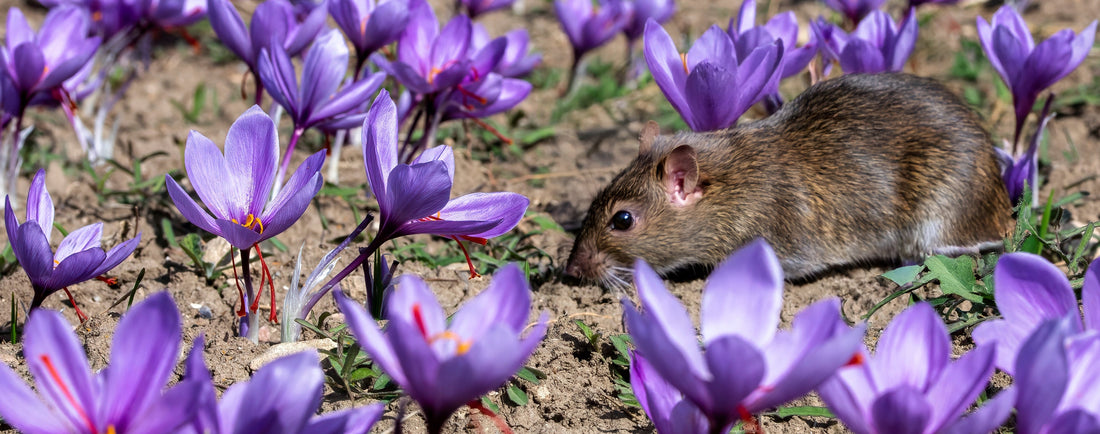
Saffron bulb pest and disease guide
Share
At Roco Saffron, we believe great saffron starts long before flowering. It begins with strong, disease-free Crocus sativus bulbs and continues with smart field management.
Pests and diseases can affect saffron quality, yield, and long-term productivity—but with the right strategies, they’re entirely manageable. In this article, we’ll guide you through:
✔ Common pests that affect saffron bulbs;
✔ Common bulb diseases to watch for;
✔ Prevention and treatment strategies;
✔ Best practices for long-term crop health.
Common pests that affect saffron bulbs
While Crocus sativus isn’t particularly prone to pest damage, certain threats can still cause serious loss if left unmanaged.
1. Rodents (mice, voles, squirrels)
Damage: Eat corms underground; often unnoticed until it’s too late.
Our tips:
- Use physical barriers like fine mesh or raised beds;
- Rotate crops and avoid nearby vegetation build-up;
- Consider natural repellents or traps in affected zones.
Read more on how to avoid rodents in saffron farming
2. Nematodes (root-knot, stem)
Damage: Tiny roundworms that feed on roots and corm tissue, reducing vigor.
Signs: Stunted growth, yellowing, root galls.
Our tips:
- Use nematode-free certified bulbs;
- Practice soil solarization or crop rotation;
- Apply approved bio-nematicides if needed.
3. Soil insects (wireworms, grubs)
Damage: Feed on corms and roots, creating entry points for disease.
Our tips:
- Plow and dry the soil before planting;
- Encourage predator insects (like ground beetles);
- Use organic soil treatments where permitted.
Common saffron bulb diseases
Even in optimal conditions, pathogens can appear—especially in poorly drained or overused soils.
1. Corm rot (fusarium spp.)
Cause: Fungus thriving in warm, wet conditions.
Symptoms: Soft, rotting corms; foul smell; yellowing leaves.
Our tips:
- Plant only clean, disease-free bulbs;
- Improve drainage and avoid overwatering;
- Disinfect planting tools and remove infected plants immediately.
2. Penicillium rot
Cause: Blue/green mold common in storage or transit.
Symptoms: Fuzzy mold on bulbs, especially if damaged.
Our tips:
- Handle bulbs gently during planting;
- Store in dry, cool, ventilated conditions;
- Always order bulbs from trusted sources with strict post-harvest protocols.
3. Sclerotium rot (white mold)
Cause: Soilborne fungus (Sclerotium rolfsii).
Symptoms: Wilting plants, white fungal threads on soil or bulbs.
Our tips:
- Rotate fields.
- Keep beds clean.
- Solarize infested areas during off-season.
General prevention tips
The best pest and disease management is preventive, not reactive. Here’s how to keep your Crocus sativus bulbs and fields healthy year-round:
- Start clean: Only plant bulbs that are certified, clean, and soil-free (Roco Saffron ensures this);
- Drainage is key: Waterlogged soil is the #1 enemy of saffron bulbs. Raised beds and light soils work best;
- Sanitize tools and crates: Prevent the spread of spores and bacteria;
- Rotate wisely: Avoid replanting saffron in the same soil for too many years in a row;
- Inspect regularly: Catching issues early is the easiest way to stop them.
Why it starts with the right bulbs
A healthy saffron crop begins with healthy bulbs. At Roco Saffron, we supply high-quality Crocus sativus bulbs that are:
- Carefully inspected for disease and rot;
- Grown under strict hygiene conditions;
- Stored and shipped in ventilated, dry containers;
- Certified and ready for export worldwide.
We know how much work goes into a successful saffron harvest. That’s why we put just as much care into bulb quality and protection as you do into your fieldwork.
Need guidance on field prep or pest control in your region? Get in touch with us—we’re here to help you grow the healthiest saffron possible, from the first bulb to the final bloom.
